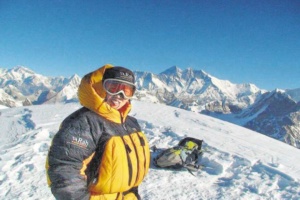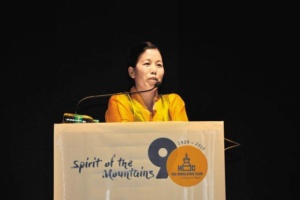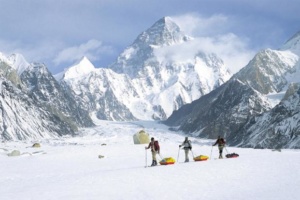Maya Sherpa comes from a remote village, where just going to school was a hurdle for girls. She took on every challenge that came her way and fought on to eventually lead the first women trio up K2.

First published:
https://www.livemint.com/Home-Page/ZlLREv7hB4DYfd14wjpw3O/Climbing-the-K2-Into-thin-air.html
Climbing the K2: A first for Nepalese women
Despite countless challenges, the first trio of Nepalese women reached the top of K2 in 2014—they were led by Maya Sherpa
When Maya Sherpa, 38, stood on top of Ama Dablam (6,812m) in 2003, there was plenty to cheer about. She was the first Nepalese woman to reach the summit, a good two decades after the first ladies got there. It was also the first mountain she had attempted and successfully climbed, quite against all odds.
In that moment of triumph though, there was only one thing that Maya really wanted to do—get down as soon as she could.
“I was so cold, I couldn’t even talk. My equipment was inadequate—a borrowed jacket from my mother, other gear from my brothers, old crampons from the office stores and woollen gloves that had led to frostbite. I had no idea why I was standing there, because I had never dreamt of climbing a mountain. The way I saw it at the time, it was just an opportunity to make some money by guiding an Australian woman who wanted to climb Ama Dablam,” Maya said on a visit to Mumbai, during The Himalayan Club’s annual seminar in February.
After what seemed like an age, she was finally at base camp. The accomplishment only registered once she reached Kathmandu. For the next month, Maya was at the centre of a media frenzy that she had hardly expected before the expedition.
“Big photo in the newspaper, a bigger headline. I said—wow, I think this is a good thing that I’ve done. For the first time in my life, I had money and was also famous,” she says, giggling.
While growing up in an obscure corner of Nepal, the mountains held a very different meaning for Maya. In her village of Patle Ripal, in Okhaldhunga district, they stood for hardship, which was a way of life for the people who lived there. Of her nine siblings, five died young due to a lack of medical facilities. Most of her time at home was spent working in the fields or collecting firewood, while tending to the toddlers.
It was only because of her father, Nawang, that Maya was pushed to attend school—a gruelling 4-hour round trip up and down the slopes, until she moved to her uncle’s home in Kathmandu.
“My father worked as a trekking guide. He had seen the world outside our village, interacted with foreigners and would tell us about different cultures, especially when it came to the status of women. What delighted me, however, was the leftover macaroni and chocolates he would bring with him. I too wanted to be like him so that I could travel and get paid for it,” she says.

For the next three years, from 2006-09, the two went climbing together as part of their work and also on holidays. During this time, Maya climbed Everest twice—via both the North Col and South Col routes (she made it a hat-trick in 2016). Life changed in 2010 when they had a baby, Roos. From a routine that saw her in the wilderness for weeks, she now had to make peace with a very different lifestyle.
“It was really hard initially. Arnold was usually away and each time he returned, I asked him if I could go. He never forced me to stay home, but I knew it was important. This baby was now my life,” she says.
Once Roos was over four years old, Maya itched to return to the mountains. A few detractors told her she would never be able to climb the way she had been able to earlier. It egged her on further and she narrowed down on a target that would prove them all wrong if she did succeed.

After years of denying climbers, K2 (8,611m) has earned the moniker “The Savage Mountain”. As the Lounge 14 April cover story detailed, frequent bad weather and the steep mountain make K2 a particularly arduous climb. Since it was first summited in 1954 by an Italian expedition, 306 climbers have reached the summit, while 81 have been killed attempting it, at a death rate of 26.47%. In comparison, 6,208 have summited Everest while 257 have been killed—a death rate of 4.14% since 1953, according to the Himalayan Database and 8000ers.com (figures updated until 2013-14). It was a daunting task, yet a rewarding challenge.
She reached out to an old friend, Pasang Lhamu Sherpa Akita, and her cousin, Dawa Yangzum Sherpa. Their dream was to become the first women’s team to get to the top, but there was a bigger challenge to overcome first—raising funds for a climb no one really expected them to pull off. For four months, Maya’s routine involved looking for sponsors all day, while also planning the logistics of the climb as the leader.
“My teammates took a week to get back to me, since K2 has beaten so many good mountaineers. It was the same with the sponsors—a lot of people doubted our ability and spoke bad things behind our backs. For us, no sum was small—we were happy to even have ₹500,” she says.
Maya had personal challenges as well, like the heartbreak of parting with her daughter for the first time. “A week before leaving, I could hardly let go of Roos. This time, my husband would be home while I would go climb a mountain. Besides, I didn’t know if I would see her again, given K2’s reputation,” she says.
Her struggles began during the approach to the mighty peak, though this hardly bogged her down.
“I was always the last to reach camp—let’s just say I was quite fat, so I couldn’t keep up with the rest. But I accepted the fact that I hadn’t been actively climbing. I’m usually the joker of the team and continued cracking my teammates up all the way to base camp,” she recalls.
Backed by Sherpas, the team made rapid progress over the next few weeks while climbing via the Abruzzi Spur. During the final summit push, however, the trio were stranded at the Bottleneck, a geographical feature at around 8,200m. The climber fixing ropes ahead of them was having a tough time negotiating the route. For 4 hours, Maya looked up at the hanging seracs, hoping they wouldn’t come loose. As her body got colder owing to the exposure, and the mind restless, she wondered if the cynics would have the last laugh. When they finally got going, she realized they had run out of rope a few hundred metres short of the summit. The soft snow and the hard ice beneath it made it a risky proposition to go unroped. A quick check with other climbers produced bits of spare rope that were knotted together to secure the route to the top.
On 26 July 2014, at 3.35pm, the three became the first Nepalese women to reach the summit of K2—a feat that was celebrated by the mountaineering community at large.
“My family is really proud after all these years, but at the same time, they think it’s time to stop. They know that I’m not going to be lucky all the time. But I’ve struggled to get where I am today and the reward is that much sweeter. It’s what drives me on and I hope to inspire other Nepali women to find their calling,” she says.
This spring, Maya—as part of a bid to climb the three highest mountains of the world—made a second unsuccessful attempt on Kanchenjunga. It will not be surprising if she decides to have another go sometime in the near future. After all, every time someone said it wasn’t possible, Maya showed them just how it’s done.